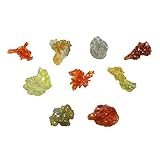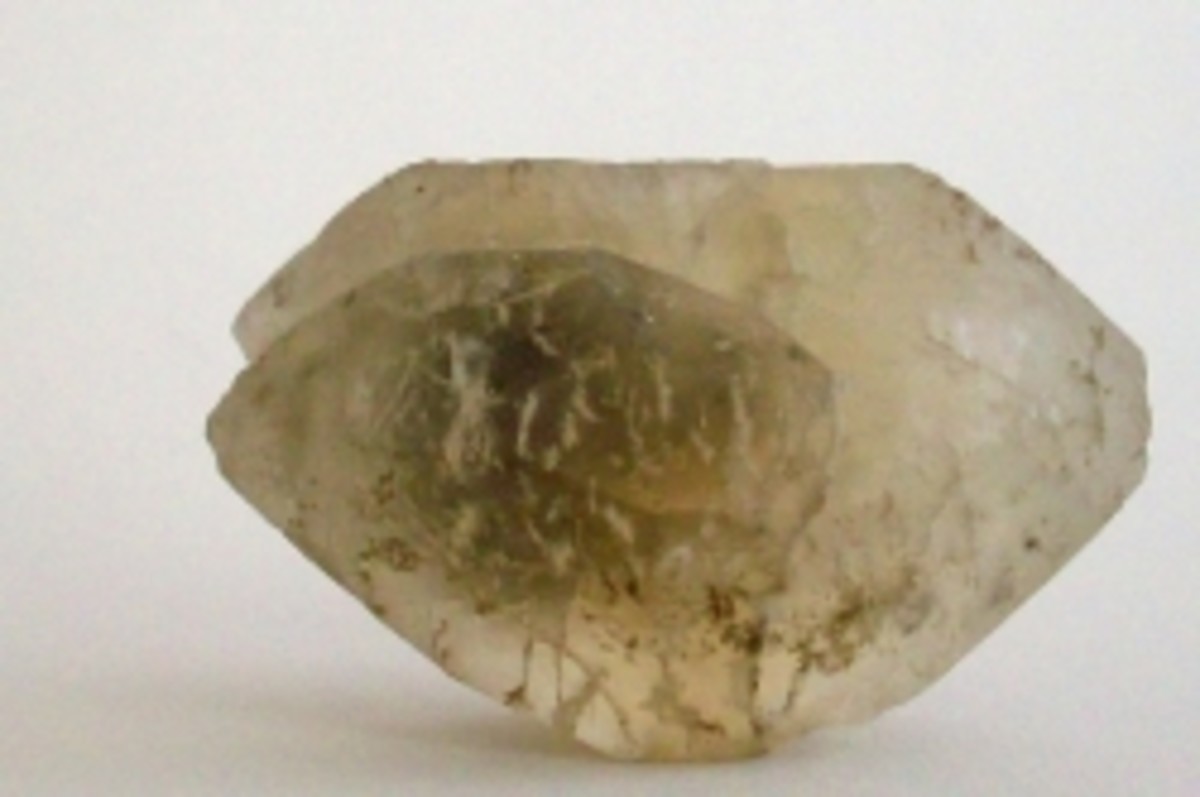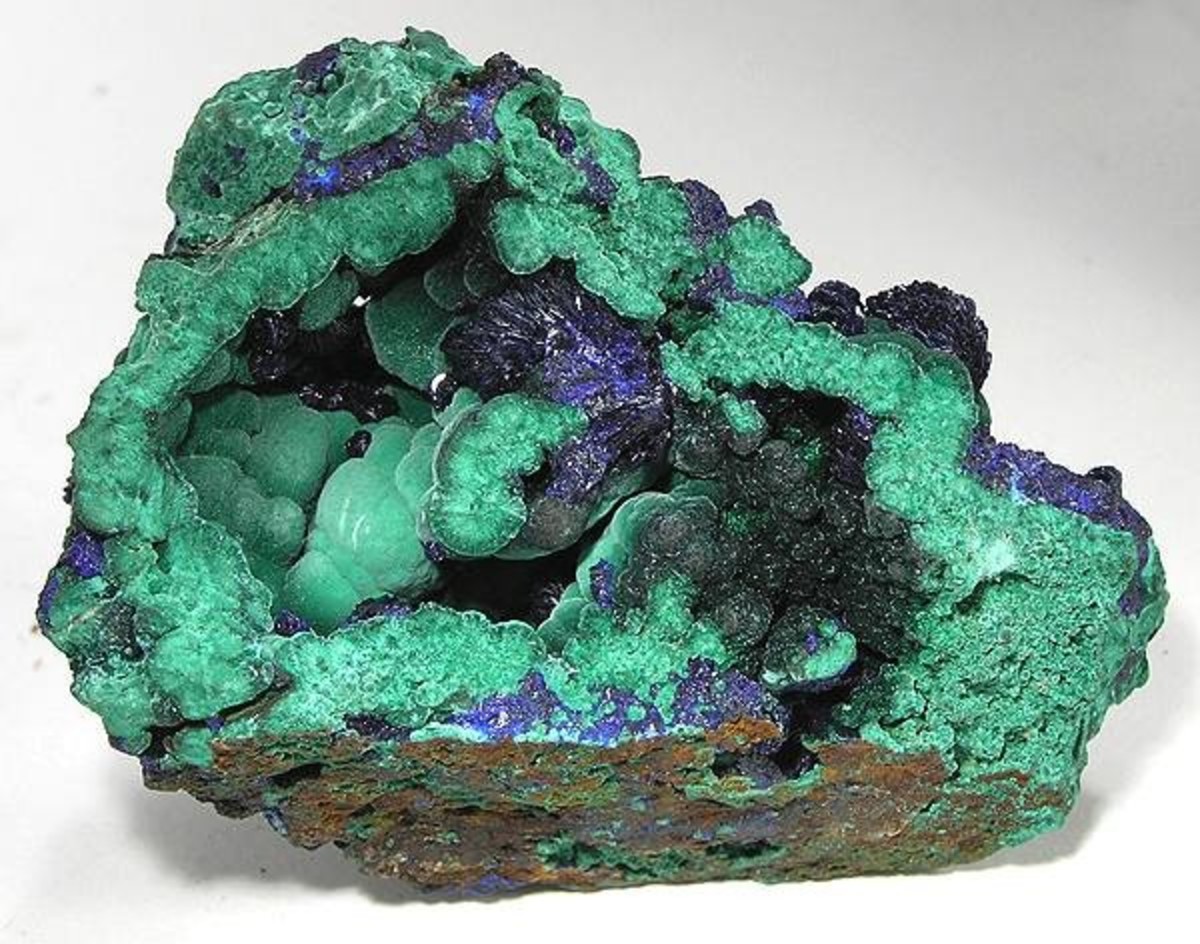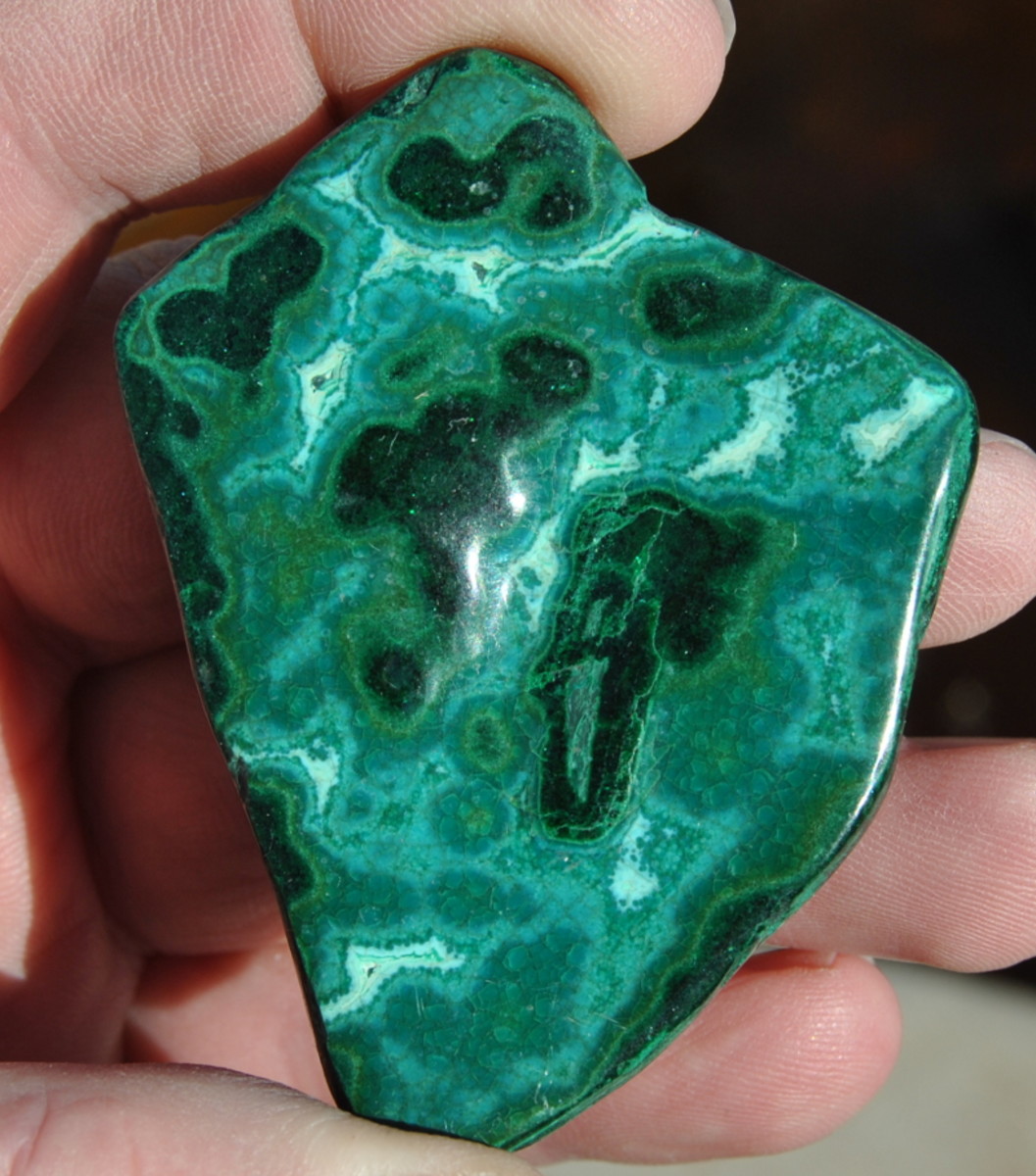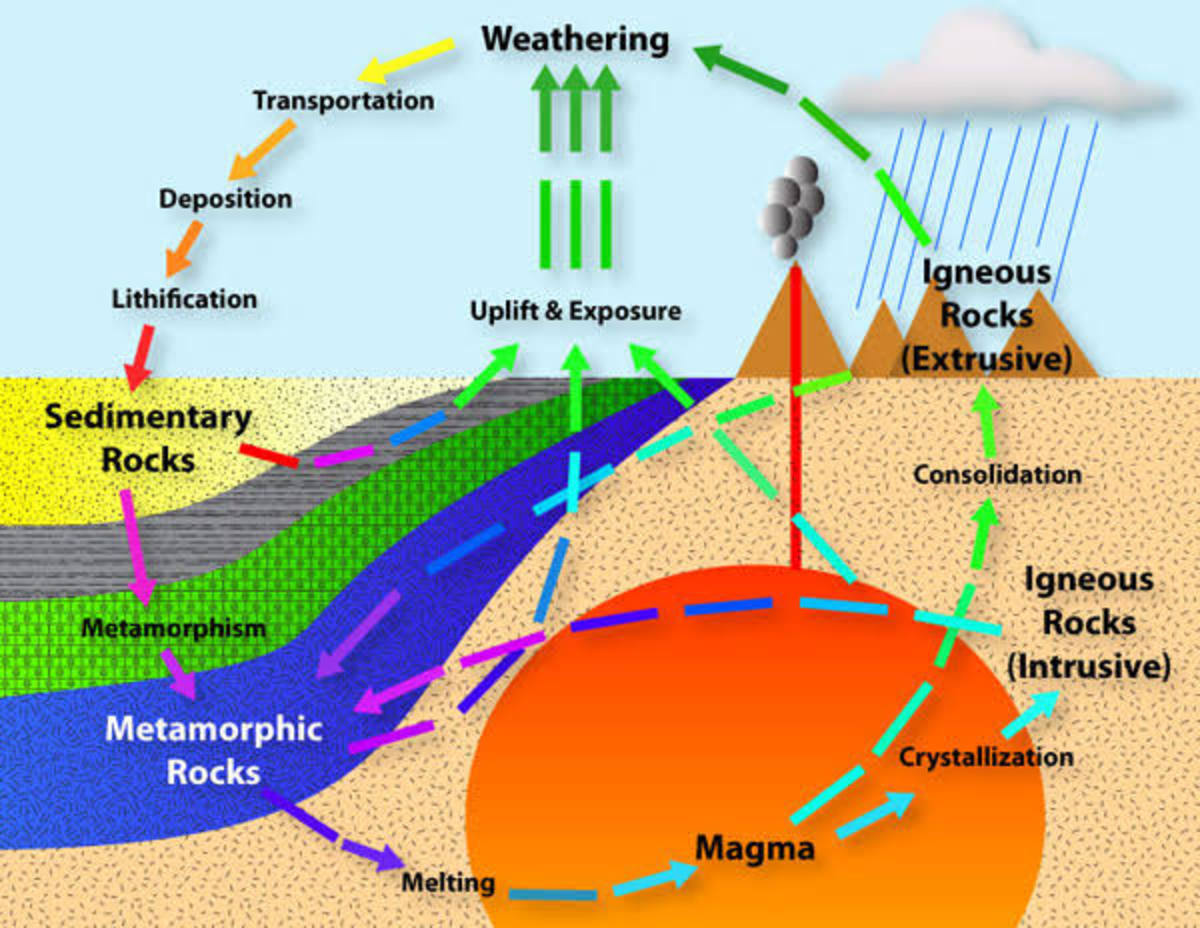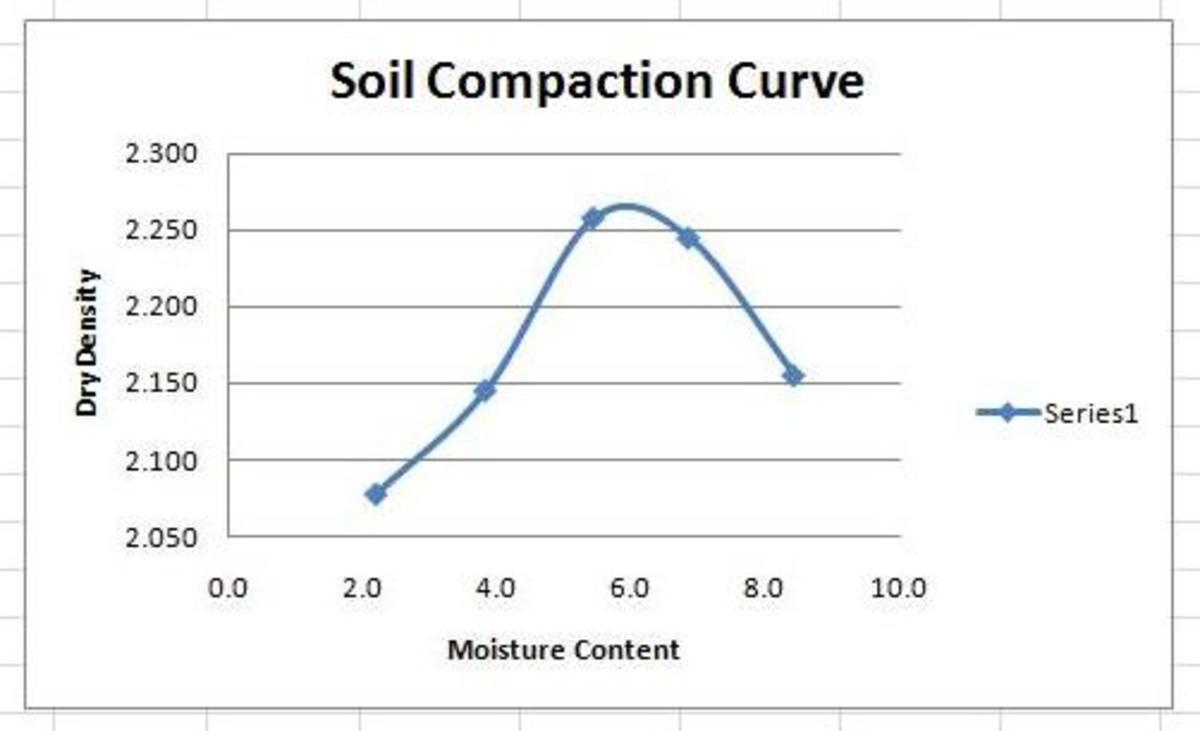The Alphabet in Minerals
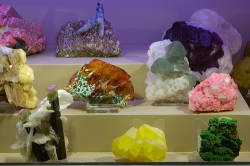
Do You Know Your Mineral ABCs?
There are hundreds of minerals in the world. There are minerals in our houses, in our yards, and even in our foods.
To make it a bit more fun to learn about some of the many minerals that exist, I picked one from each letter of the alphabet and am sharing pictures and information on them.
Minerals are lots of fun and are super pretty, so enjoy!
A is for Azurite
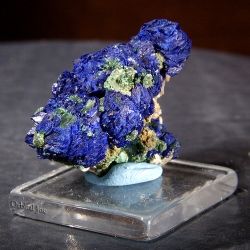
A is for Azurite
Azurite is named for azure, the deep blue color that azurite is known for.
It is related to copper and will frequently appear near where copper is mined. It is most commonly found with Malachite, another copper mineral that is a beautiful green color.
Other names for Azurite: Copper Carbonate Hydroxide, azure copper ore, or Chessylite
Azurite's mineral group: Carbonates
Uses of Azurite: Azurite was once ground and used as pigment. Now it is usually used to make jewelry, as a decorative stone, or occasionally cut into ornamental pieces.
Healing powers of Azurite: Azurite enhances psychic abilities and cuts through illusions, enhances creativity and inspiration. It is connected to the throat and is supposed to help sore throats, asthma, and thyroid problems.
B is for Biotite
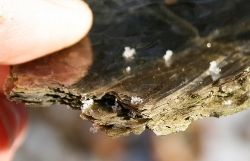
B is for Biotite
Biotite is a type of mica. It is known for its dark brownish color and thin, slightly flexible sheets that can be pulled off the main mass. When carefully pulled off, the sheets can be so thin you can see through them and it's a lot of fun to play at peeling sheet after sheet away even after you think it's impossible to coax another away.
Biotite is not the only mica. A good way to remember the difference between biotite and muscovite (a lighter-colored mica) is that biotite starts with b, the same letter as black, and muscovite sounds like Moscow, which is often snow-covered and white.
Other names for Biotite: Iron Mica, Micaceous Iron Ore
Biotite's mineral group: Silicates
Uses of Biotite: Biotite is useful in checking how old rocks are, and also seeing what temperatures the rocks have been exposed to in the past
Healing powers of Biotite: As seems apt for a mineral you can see through Biotite helps you see your placement in life and the world and helps give you a clear picture while getting rid of details that would obscure the issues. As such it can be useful for crystal healing when disorders are caused by disorganized cell patterns. It is also used in crystal healing to fix eyes, shrink growths, and in regulating bile.
Get Some Biotite
C is for Calcite
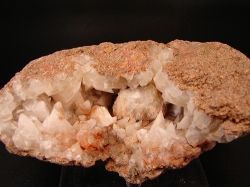
C is for Calcite
Calcite is an extremely common mineral. In fact, you could go outside and probably find some within a few minutes.
Some calcite is so clear that you can see through it, but the images seen through the crystal will be a bit offset. This effect is called double refraction or the "beer goggle" effect and the type of calcite is called optical calcite.
If acids such as vinegar are dripped onto calcite, it will fizz as the carbon dioxide gas inside is released. It may also be fluorescent when seen under black light.
Calcite's mineral group: Carbonates
Uses of Calcite: Really, really nice calcite of a certain variety was used for gun sights in World War II.
Healing powers of Calcite: Calcite brings inner peace, and increases creativity, imagination, and prosperity, while also helping to reduce stress and fear.
Get Beer Goggle Effect Calcite from Amazon
D is for Diamond
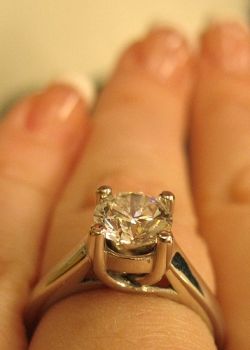
D is for Diamond
Diamond is of course known well for its use as a gemstone. It has many industrial uses as well, especially where a very hard material is needed such as saw blades.
It is the hardest of all known minerals, so diamond chips and dust are used for cutting things that would be too hard to cut otherwise. It is also used as a point on the Mohs Hardness Scale- a scale used by geologists to asses how hard a mineral is. The scale goes from talc to diamond, with diamond being the hardest at number 10.
Diamonds are naturally colorless, leading to the classic look we typically think of when we think of diamonds. Due to slight impurities or structural differences, they can also vary in color. Diamonds can be red or pink, orange, yellow, green, blue, purple, brown, gray, white, and black.
Diamond's mineral group: Native Elements
Uses of Diamond: Jewelry, as tipping for cutting blades
Healing powers of Diamond: Diamonds increase- whether one's thoughts, strengths, or weaknesses. Crushed diamonds have been ingested and used as a cure for various illnesses.
Get Some Diamonds
E is for Epidote
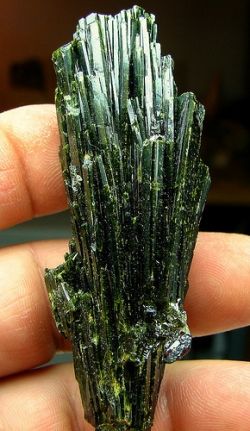
E is for Epidote
Epidote is a mineral that's usually green.
Though much of the time it's pistachio-green, nice pieces remind me of evergreen branches in both color and form.
Epidote's mineral group: Silicates
Uses of Epidote: Very nice pieces can sometimes be cut for gemstones, otherwise it's a nice addition to a mineral collection.
Healing powers of Epidote: Epidote crystals can be attuned to all sorts of stuff. It helps agoraphobics, Parkinson's suffers, those with brain disorders, digestive problems, cystic fibrosis, and thyroid disorders. It makes you more perceptive and increases your personal power. Besides giving you strength and insights, it detoxifies your emotions and body and helps manifest your dreams.
Epidote makes a great gift for those who are in the hospital since wearing it is supposed to ease recovery after surgery.
F is for Fluorite
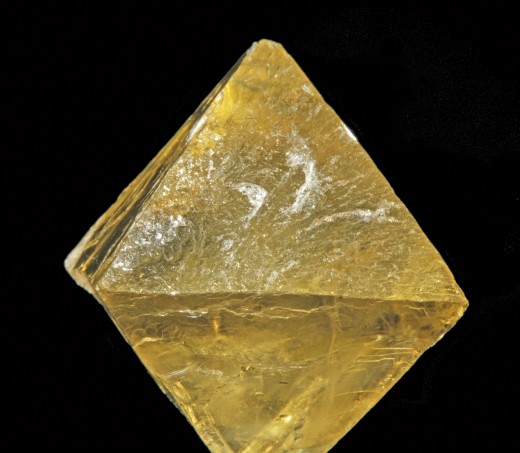
F is for Fluorite
Fluorite is a very pretty mineral and one of my favorites.
It breaks apart into little crystals shaped like two pyramids stacked one on top of the other and it comes in pretty colors like light blue, white, yellow, pink, dark purple, and of course light purple.
A Pile of Various Colored Fluorite Crystals
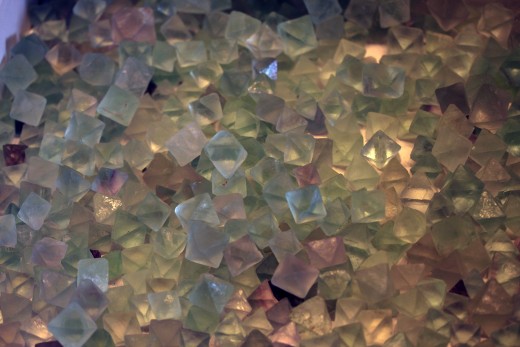
Fluorescent Fluorite
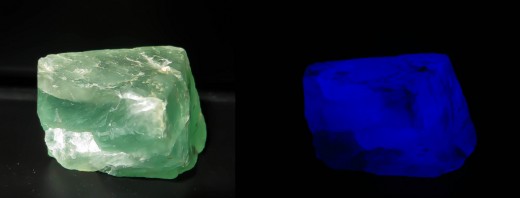
G is for Galena
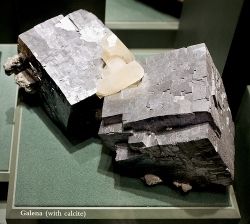
G is for Galena
Galena is very neat.
Straight out of the earth it can look like silver cubes of metal.
H is for Halite
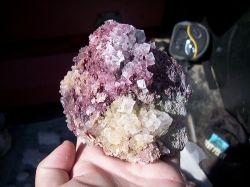
H is for Halite
His for Halite, a mineral well-known. That's because you probably have it all over your home.
Halite is also known as salt, so it's what you sprinkle on your dinner, just a sprinkling makes your food taste like a winner.
And did you know? A special type is used for melting snow.
We use Halite every day, just don't use too much, okay?
I is for Iolite
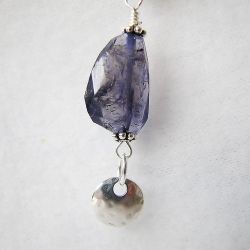
I is for Iolite
Iolite is a lovely mineral commonly used for jewelry.
It is a rich purple blue with a stunning translucent quality.
J is for Jadeite
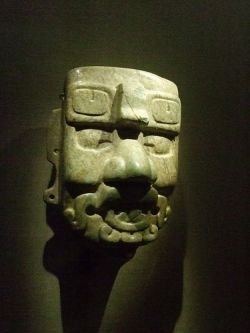
J is for Jadeite
Jadeite is just one of several minerals commonly called jade.
It has been carved for centuries by many cultures.
Jadeite usually comes in shades of pale green to almost white and richer green colors.
Get Some Beautiful Carved Jadeite Now
K is for Kyanite
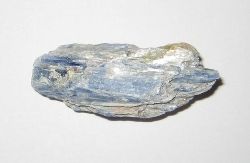
K is for Kyanite
Kyanite is a fairly common mineral.
It is soft blue with creamy grey streaks and is often very smooth and almost greasy feeling.
It is sometimes used for jewelry, or just something pretty to lay around.
Kyanite is often tumbled.
L is for Labradorite
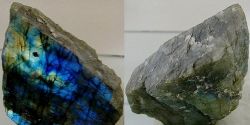
L is for Labradorite
Labradorite is a very popular mineral for display. It has an iridescent sheen to it, that flashes blue, yellow, and teal rainbows when it's moved and light glints off of it.
When light isn't showing off the iridescence it looks very plain light blueish gray.
Healing powers of Labradorite: Labradorite is one of the best stones for working with physic abilities, astral projection, and the third eye. It is protective against negative energies and helps balance the aura. It is considered useful during times of change.
Get a Beautiful Labradorite Stone
M is for Muscovite
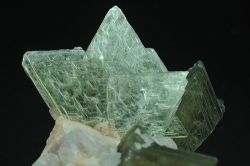
M is for Muscovite
Mis for Muscovite, a mineral known, not for what isn't seen, but instead for what is shown.
Muscovite is light, sort of a whitish gray. It is made up of sheets, that when pulled away, reveal what's on the other side.
Muscovite isn't like a mirror, instead it can be almost clear. Often called miner's glass, Muscovite used to be used for a window's task.
Muscovite is fun to play with all day long, pulling the sheets away from each other, though their bond is fairly strong. The sheets that make up this type of mica stick together, through good and bad weather, but if you use a bit of tact, you might be able to pull them back, then look through what looks like a piece of glass in your hand.
If you get some Muscovite, I know you can.
Get Some Muscovite
N is for Neptunite
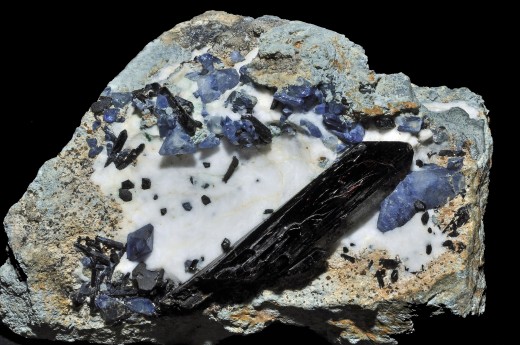
N is for Neptunite
Neptunite is named for the Roman god of the sea, Neptune. It is deep, deep black, like the sea deep below.
It frequently appears as black crystals on a white mineral called Natrolite. Sometimes it's found with Joaquinite and Benitoite.
Neptunite's Mineral Group: Silicates
O is for Okenite
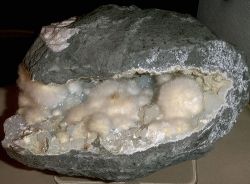
O is for Okenite
Okenite is a tiny delicate mineral that looks like little cotton balls.
It is extremely fragile and so should never be touched.
The crystal growth makes it look like tiny white hairs in a little powdery ball shape.
Get Okenite Crystals Now
P is for Pyrite
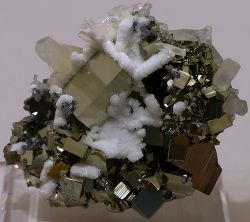
P is for Pyrite
Pyrite is also known as fools gold since many people discovering it think it is gold.
It of course is not gold, or even related closely to gold. It just happens to look similar, though pyrite is more brassy color than gold.
Gold is very dense. So, if you are panning for gold it will fall to the bottom of the pan and not splash out while pyrite may even stay suspended and will rinse out of the pan if you are doing it right.
Gold is fairly soft and maliable, but if you try to cut pyrite it will shatter.
Q is for Quartz
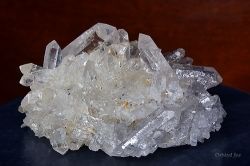
Q is for Quartz
Quartz is one of the most common minerals. In many areas of the country, simply by looking through a selection of rocks from outside you can easily find a piece.
There are many colors of quartz, everything from black to clear. Most of the various colors of quartz are called by different names depending upon their color.
Amethyst is purple quartz.
Rose is pink quartz.
Citrine (pronounced like citrus) is yellow to brown quartz.
Smokey Quartz is usually a smoky gray color.
Chalcedony, Agate, Onyx, Jasper, Aventurine, Tiger's Eye, and Carnelian are all types of quartz too.
Get Different Kinds of Quartz
R is for Rhodochrosite
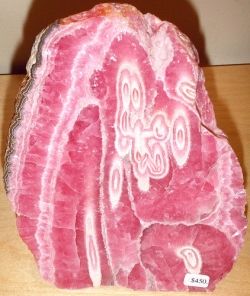
R is for Rhodochrosite
Rhodochrosite is usually a very pretty pink mineral.
It varies in color from pale pink to light brown, but the purer it is the closer it is to a rose-red color.
My favorite pieces of Rhodochrosite have pale and darker bands that look absolutely lovely, but much of it is too soft to use for jewelry, so it's mainly for stunning displays.
It is Colorado's state mineral, as well as Argentina's national gemstone.
It is sometimes called Inca Rose because the ancient Incas believed that Rhodochrosite was the blood of their former kings, and that it had been turned to stone.
S is for Stibnite
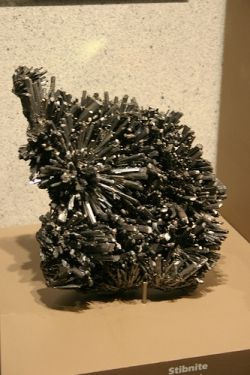
S is for Stibnite
Stibnite is a metallic looking mineral in grey, though when exposed to air it can turn black.
It should be handled with care since it can be poisonous.
For thousands of years people have made a mixture of ground stibnite and fat to use as eye makeup called kohl. They would use it as eyeliner and to darken eyelashes and eyebrows.
They also use stibnite in fireworks, specifically the ones that look like waterfalls or that glitter.
Mineral group: Sulfides
Other names: Antimonite, Antimony Trisulfide, Chinese Needles
One of My Favorite Rock and Mineral Guides

T is for Turquoise
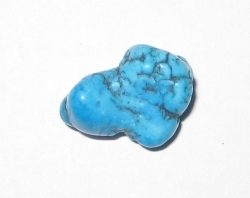
T is for Turquoise
Turquoise is a mineral that most people have seen. Good pieces are not very common, but even poor specimens can be dyed to show the beautiful green blue color that turquoise is known for.
Turquoise of course comes in turquoise color, as well as many other shades in the blue and green spectrums.
It is commonly used in jewelry, especially pieces from the southwest United States.
It has been popular in desert regions all over the world for thousands of years and is considered one of the first gemstones ever mined.
The ancient Persians used it to cover domes in their palaces. The Egyptians used it in the death mask of Tutankhamen. The Aztec Kings used it on ceremonial masks. Even the Chinese dynasty used turquoise. And of course the Southwestern US Indians made incredible jewelry from their turquoise deposits.
Turquoise has long been an extremely popular gemstone with people crediting it with revealing the health of the wearer. It's also been used in a lot of amulets for it's protective properties.
Other names: Callais, Phirouzeh, Teoxihuitl
U is for Ulexite
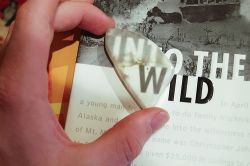
U is for Ulexite
Ulexite is also known as the TV rock because when placed over a picture the image seems projected through the rock itself. The individual fibers that make up the rock behave like fiber optics.
It is a bright white mineral most commonly found as chunks or in rocks made up of bundled fibers or small tufts like cotton balls.
If placed into hot water, Ulexite will break down and be ruined.
Mineral group: Borates
Buy Some Ulexite on Amazon
V is for Vanadinite
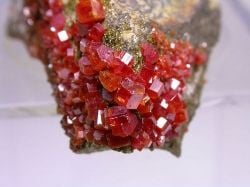
V is for Vanadinite
Vanadinite is a gorgeous mineral that some people mistake for ruby, but it is actually a different color range from rubies.
Vanadinite is more of an orange, orange-red, or red-orange usually, that tends toward brown.
Buy Some Vanadinite
W is for Wavellite
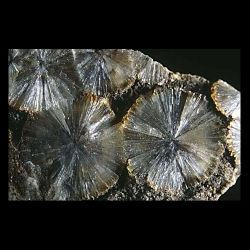
W is for Wavellite
Wavellite is usually greenish-yellow to green mineral with hints of yellow, brown, and white.
What makes Wavellite especially interesting is that it can be found as radial or spherical clusters that are quite simply gorgeous.
It usually is fairly translucent, which makes for a neat effect with the radiating mineral needles.
Mineral group: Phosphates
X is for Xenotime
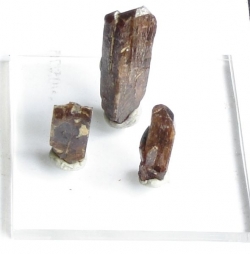
X is for Xenotime
Xenotime is usually found in shades of brown, yellow brown, reddish, and greenish brown, as well as gray.
The mineral is varies in shape quite a bit, sometimes being short and stubby crystals, other times long and elongated, sometimes rosettes or radials.
Xenotime is usually used as a source of yttrium, though sometimes nice pieces are cut for gemstones.
It should be handled at least somewhat carefully because it can sometimes be contaminated with arsenic and even uranium, which can sometimes make it slightly radioactive.
Mineral group: Rare earth phosphates
Get a Rare Xenotime Crystal
Y is for Yugawaralite
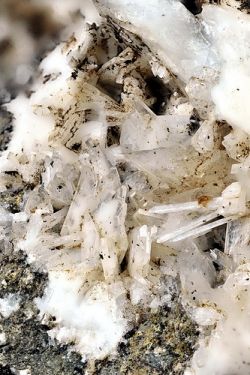
Y is for Yugawaralite
Yugawaralite is named for the Yugawara Hot Springs in Honshu, Japan where it was originally found.
It is usually colorless to semi-translucent pearly white and it is brittle.
It is also fairly rare.
Yugawaralite is one of many minerals that are a bright white. It looks a bit like snow.
Mineral group: Silicates, specifically Tektosilicates
Yugawaralite Discovery Location
Z is for Zincite
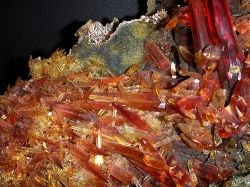
Z is for Zincite
Zincite is the mineral form of zinc oxide, you know that stuff you rub on your nose at the beach? Zinc oxide is also the basis of calamine lotion and some paints, it's put into many products we use every day like baby powder and dandruff shampoo and even breakfast cereal for the added zinc.
While zinc oxide is common, Zincite is fairly rare because it's difficult to form the crystals in nature. They are being created in labs though, and before vacuum tubes were used in radios many used real and synthetic Zincite crystals as semiconductors.
Zincite is usually a yellow-orange color, all the way to deep red, though it is sometimes green or colorless or even yellow. No matter what color it is though, if you drag it across a white non-glazed piece of ceramic it will leave a yellowish-orange streak.
It is usually found as small colored flecks in a rock.
Mineral group: Oxides
Healing powers of Zincite: Zincite is energizing and mood-lifting. It increases inner strength and is supposed to bring together many aspects of one's self as well as help one's creativity. It is connected to the solar plexus and naval chakra.
Get Some Zincite
See My Other Pages on Rocks and Minerals and the Earth
- Hanksite: An Unusual Mineral
Hanksite is a rare and unusual mineral that is quite lovely and fun to collect. - Obsidian Collecting
Obsidian, or as it is sometimes called, volcanic glass, is a naturally occurring rock that comes from volcanoes. When lava cools very, very quickly it can turn into obsidian. Obsidian is usually deep black in color and used for making arrowheads. - Diatomaceous Earth
Diatomaceous Earth is a powdered rock called diatomite. It is a material composed of tiny diatoms and mined to be used as a safe pest control, food additive, and for numerous other uses. Chemically-altered DE is also used in pool filters.
© 2009 Alisha Vargas













